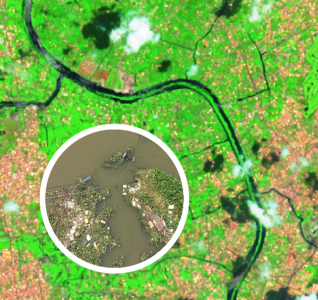Plastic Plants: Detecting water hyacinth patches as a proxy for riverine plastic transport

The project, part of the ESA Discovery Campaign on Remote Sensing of Plastic Marine Litter, developed a method to estimate floating macroplastic accumulation and transport rates in rivers using remote sensing. It combined the detection of floating water hyacinths using Sentinel-2 and Sentinel-1 with in-situ estimates of macroplastic densities carried by this invasive aquatic weed. Water hyacinths typically form large patches of several meters of width and length, and can thus be detected from space. Our results show that they aggregate 55-65% of floating plastic debris (one-year average) in tropical rivers. The detection tool and field measurements focused on the Saigon river, Vietnam, a river highly invaded by hyacinths. We estimated river surface plastic densities at 1.1 x 105 items km-2 for a 11 km2 area of the Saigon river. This is within the range of in-situ measurements conducted over the same river. These plastic densities are equivalent to 0.6-1.1 tonnes km-2, considering an average mass per item of 5-10 g item-1 .Floating plastic transport rates were estimated at 105 items hour-1, also in agreement with in-situ measurements. The algorithms and spectral libraries may serve for future applications, notably for other tropical river systems invaded by hyacinths. Given that tropical rivers invaded by hyacinths typically overlap with the highest plastic polluted waterways, this detection system could serve for global monitoring purposes.
